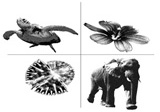

The conservation movement in North America emerged out of the shock of the extinction of the passenger pigeon and the near extinction of the American bison, species that had once been considered too numerous to be depleted. By the 1960s a broad consensus emerged in the United States that species should not be driven to extinction by human activities. Since then, however, the Endangered Species Act and major programs to restore endangered and threatened species have become controversial. Property rights advocates claim that endangered species protection hampers economic activity and land development to an unreasonable extent. At the same time, some conservationists are concerned that too much money and effort are devoted to endangered species, diverting attention from protection of entire ecosystems that support numerous species.
Conference goals included providing a broad overview of current thinking about how to prevent extinction and sustain biological diversity by examining:
- the effectiveness and economics of endangered species protection
- efforts to sustain biological diversity in entire ecosystems or across regional landscapes
- the best methods for protecting biological diversity on a global scale.
Goodwin-Niering Center faculty and staff decided early in the planning process to create a video record of the presentations in order to share them with a larger audience. Links to the movies are on each presenter's web page which also includes biographical information, and a summary of the presentation.
Conference Proceedings Published
Saving Biological Diversity: Balancing Protection of Endangered Species and Ecosystems, is now available from Springer Science + Business Media, LLC. A compilation of presentations from the Center's 2007 conference, the book was edited by Robert Askins, Glenn Dreyer, Gerald Visgilio, and Diana Whitelaw. In addition to the traditional printed format, Springer also offers individual chapters for purchase in electronic form on their web site. All six previous Center conferences were also published as either books or dedicated issues of professional journals.
From the publisher:
“The distinctive contribution of this book is that it presents a pragmatic approach for preserving biological diversity. Experts in a wide variety of fields, including philosophy, environmental policy, law, economics and biology, present different perspectives on how to prevent widespread extinction around the world. Several chapters deal with basic questions such as how we should define biodiversity and how we should determine what is most important to save. Two chapters focus on how we can place an economic value on biological diversity, a step that is often critical for gaining acceptance for conservation efforts. One of the major conclusions is that people are often willing to pay to preserve natural systems that have no immediate value in terms of generating income or commodities.
Efforts to protect a particular endangered species typically lead to efforts to protect its ecosystem. Similarly, efforts to protect an ecosystem lead naturally to concerns about the atmosphere, climate and water supplies. The interdependence may also work in the other direction: loss of species potentially can undermine the stability and resilience of ecosystems, which can have a large negative impact on the biosphere. The main conclusion is that a wide range of approaches to conservation is needed to maintain diverse and ecologically functioning natural systems."